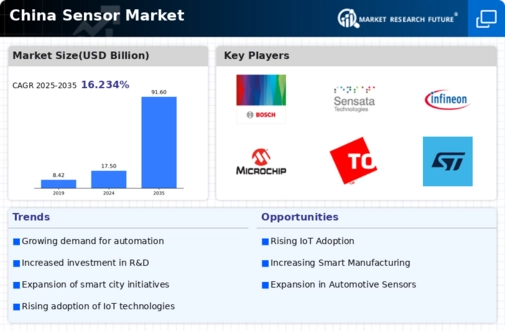Rising Industrial Automation
The sensor market in China is experiencing a notable surge due to the increasing adoption of industrial automation across various sectors. As industries strive for enhanced efficiency and productivity, the demand for sensors that facilitate automation processes is escalating. In 2025, the market for industrial sensors is projected to reach approximately $10 billion, reflecting a growth rate of around 15% annually. This trend is driven by the need for real-time data collection and monitoring, which sensors provide. Industries such as manufacturing, logistics, and energy are particularly focused on integrating advanced sensor technologies to optimize operations. Consequently, the sensor market is poised to benefit significantly from this industrial shift, as companies invest in smart technologies to remain competitive.
Government Initiatives and Support
The Chinese government is actively promoting the development of the sensor market through various initiatives and policies aimed at fostering innovation and technological advancement. Programs that support research and development in sensor technologies are being implemented, with funding allocations reaching upwards of $500 million in recent years. These initiatives are designed to enhance the capabilities of domestic manufacturers and encourage collaboration between academia and industry. Furthermore, the government's focus on smart city projects and the Internet of Things (IoT) is likely to drive demand for sensors, as these technologies are integral to the successful implementation of such initiatives. As a result, the sensor market is expected to thrive under the supportive regulatory framework established by the government.
Growing Consumer Electronics Sector
The consumer electronics sector in China is witnessing rapid growth, which is significantly impacting the sensor market. With the increasing demand for smart devices, such as smartphones, wearables, and home automation systems, the need for advanced sensors is becoming more pronounced. In 2025, the consumer electronics segment is anticipated to contribute approximately $15 billion to the overall sensor market. This growth is fueled by consumer preferences for enhanced functionalities, such as health monitoring and smart home integration. As manufacturers strive to incorporate innovative sensor technologies into their products, the sensor market is likely to expand, driven by the continuous evolution of consumer electronics and the quest for improved user experiences.
Advancements in Automotive Technology
The automotive industry in China is undergoing a transformation, with advancements in technology leading to increased demand for sensors. The shift towards electric vehicles (EVs) and autonomous driving systems is particularly influential in shaping the sensor market. In 2025, the automotive segment is projected to account for around $8 billion of the sensor market, driven by the integration of sensors for safety, navigation, and performance monitoring. As manufacturers prioritize the development of smart vehicles, the reliance on sophisticated sensor technologies is expected to grow. This trend indicates a robust future for the sensor market, as automotive companies invest heavily in research and development to enhance vehicle capabilities and meet regulatory standards.
Focus on Smart Infrastructure Development
China's commitment to developing smart infrastructure is significantly impacting the sensor market. The government is investing heavily in projects that incorporate sensor technologies to improve urban management, transportation systems, and energy efficiency. In 2025, investments in smart infrastructure are projected to exceed $20 billion, creating substantial opportunities for sensor manufacturers. Sensors play a crucial role in monitoring traffic, managing energy consumption, and ensuring public safety. As cities evolve into smart environments, the demand for reliable and efficient sensors is likely to increase. This trend suggests that the sensor market will continue to grow, driven by the need for innovative solutions that support sustainable urban development.
















Leave a Comment